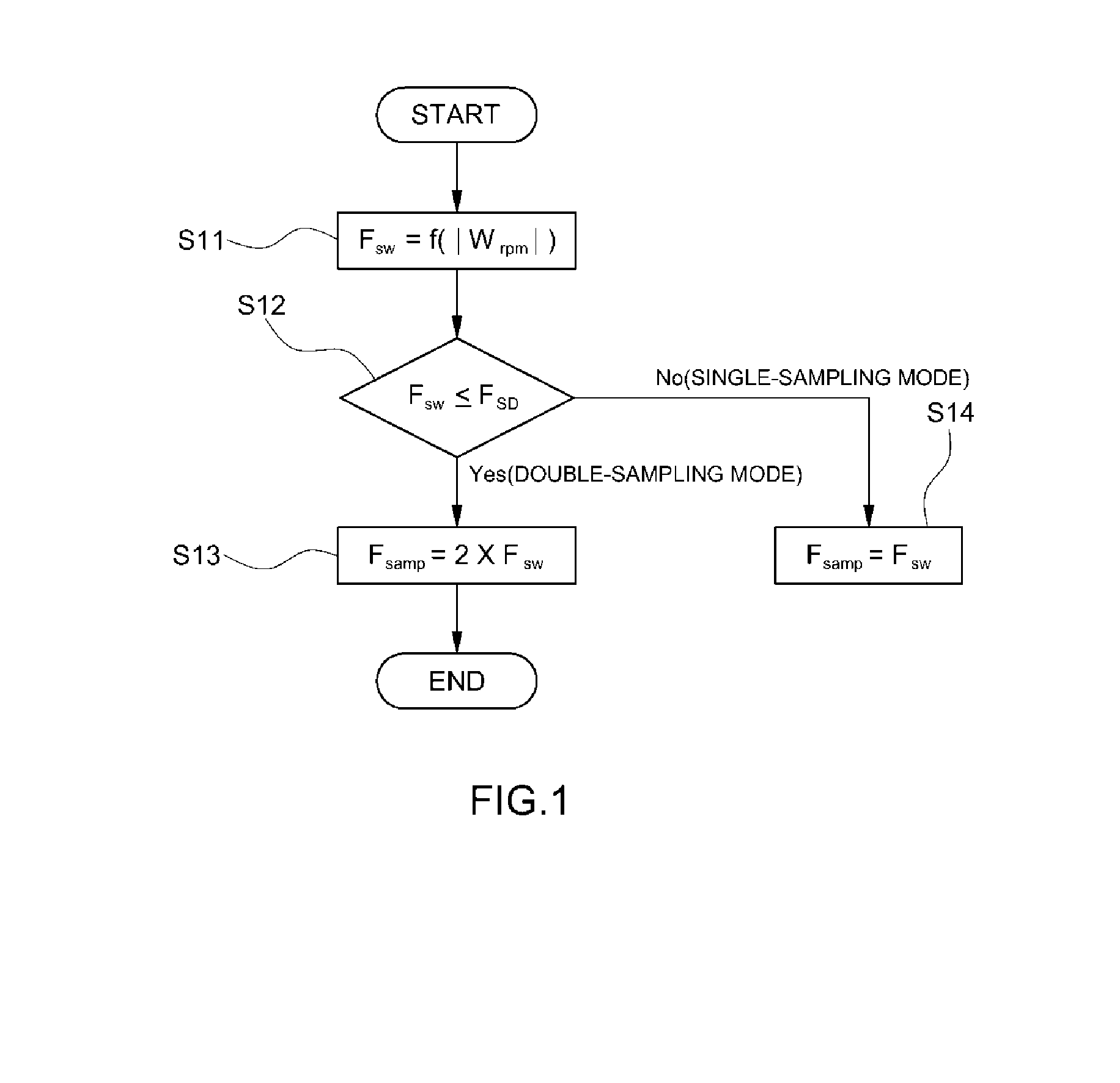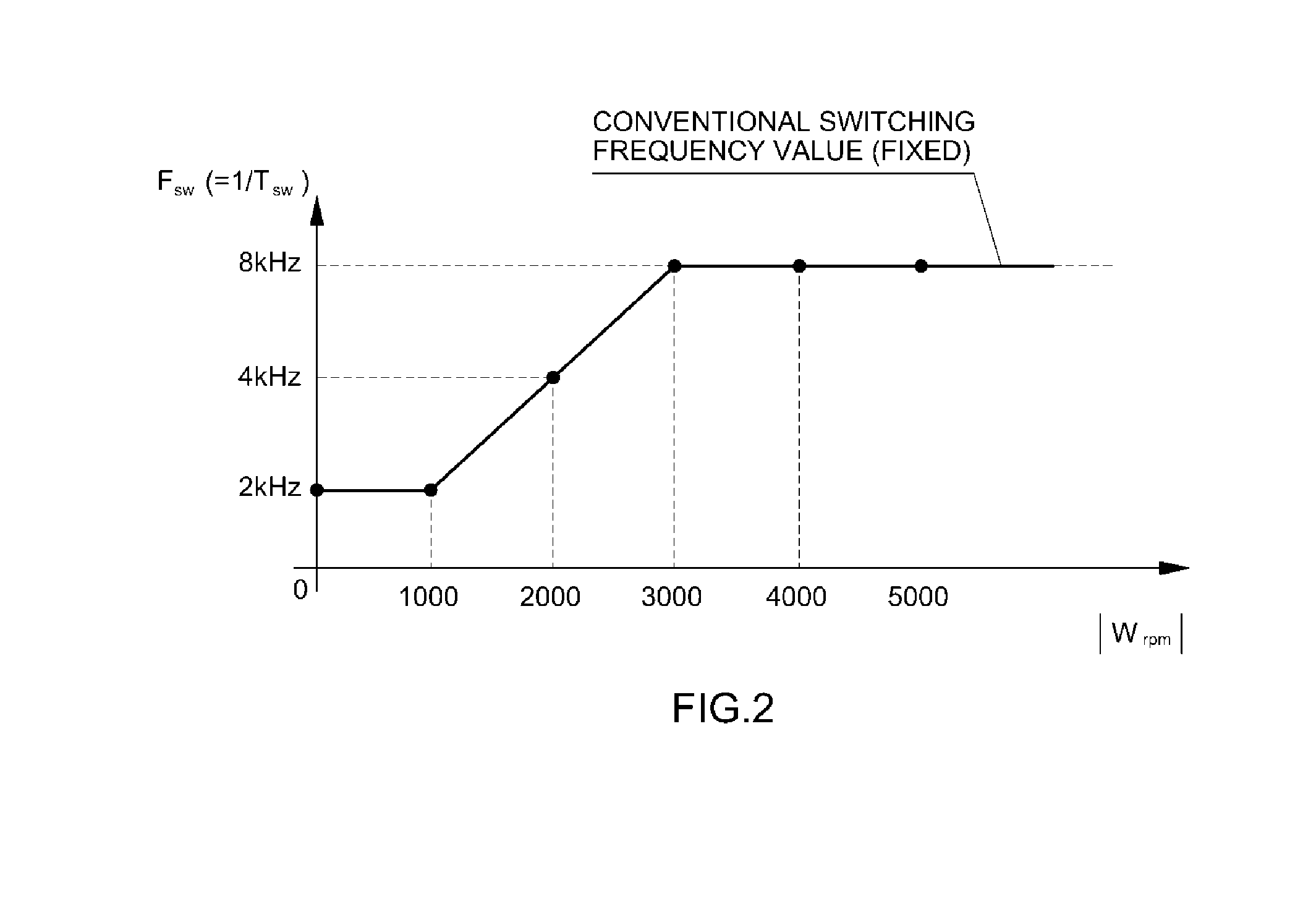Inverter control method and system for eco-friendly vehicle
- Summary
- Abstract
- Description
- Claims
- Application Information
AI Technical Summary
Benefits of technology
Problems solved by technology
Method used
Image
Examples
first embodiment
[0043]FIG. 1 is a flowchart of an inverter control method according to a first exemplary embodiment of the present invention, and FIG. 2 is a diagram showing a state where a switching frequency Fsw is variable-controlled (continuous-variable-controlled) in an inverter control method according to the present invention.
[0044]In FIG. 2, a conventional fixed switching frequency (e.g., about 8 kHz) is also shown.
[0045]FIG. 3 is a diagram showing a transition scheme of a sampling frequency Ksamp in an inverter control method according to the first exemplary embodiment of the present invention, in which the sampling frequency Fsamp changes with the switching frequency Fsw and to transition (single sampling double sampling) is performed in a particular condition.
[0046]In first exemplary embodiment of the present invention, an inverter switching frequency may be variable-controlled according to a vehicle's driving condition, and a sampling frequency may be properly controlled according to th...
second embodiment
[0077]The second exemplary embodiment further provides sophisticatedly segmented control logic in which the controller determines whether the current motor operation state is in a driving operation state or a regenerating operation state and the switching frequency Fsw and the sampling frequency Fsamp are determined from the base switching frequency Fsw—base separately for the driving operation state and the regenerating operation state. In addition, in the second embodiment, it is determined whether to conduct step transition of the switching frequency and one of the single-sampling mode and the double-sampling mode is selected, according to the current inverter input voltage, motor speed, torque command, or inverter power.
[0078]That is, when the motor is in the driving operation state, when three conditions all are satisfied: i.) an inverter input voltage VDC is greater than a preset first reference voltage VDC_cal1; ii.) the motor speed Wrpm (e.g., an absolute value thereof) is a...
third embodiment
[0105]With reference to FIG. 8, a description will be made below regarding a process of performing transition between single sampling and double sampling based on a motor speed in the inverter control method according to the present invention.
[0106]First, the controller monitors the current motor speed Wrpm and variable-controls the inverter switching frequency Fsw—nom according to the current motor speed Wrpm. The switching frequency Fsw—nom is obtained by summing the base switching frequency Fsw—base and the spread frequency Fsw—inj as stated above, and both the base switching frequency Fsw—base and the spread frequency Fsw—inj are calculated as values changing with the motor speed Wrpm, such that when the motor speed Wrpm changes, the switching frequency Fsw—nom also changes correspondingly.
[0107]Referring to FIG. 8, in step S11 where the switching frequency Fsw—nom is calculated as a value corresponding to the motor speed Wrpm, the switching frequency Fsw—nom is determined as a ...
PUM
 Login to View More
Login to View More Abstract
Description
Claims
Application Information
 Login to View More
Login to View More - R&D
- Intellectual Property
- Life Sciences
- Materials
- Tech Scout
- Unparalleled Data Quality
- Higher Quality Content
- 60% Fewer Hallucinations
Browse by: Latest US Patents, China's latest patents, Technical Efficacy Thesaurus, Application Domain, Technology Topic, Popular Technical Reports.
© 2025 PatSnap. All rights reserved.Legal|Privacy policy|Modern Slavery Act Transparency Statement|Sitemap|About US| Contact US: help@patsnap.com



